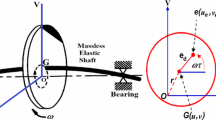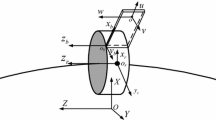Abstract
The destabilizing influence of the internal friction on the supercritical rotor whirl can be efficiently counterbalanced by other external dissipative sources and/or anisotropic suspension systems. The theoretical approach may take the internal dissipation into consideration either by dry or viscous models. Nevertheless, several numerical results and a new perturbation technique of the averaging type prove that similar rotor motions and stability limits are achievable by both models, whence the linear viscous assumption appears preferable. Thus, the internal hysteretic force may be expressed by the product of an equivalent viscous coefficient and the rotor centre velocity relative to a reference frame rotating with the shaft end sections. After calculating the natural frequencies and the response to dynamic imbalances, the stability of the steady motion is checked by the Routh-Hurwitz criterion, focusing the analysis on the individual influence of several characteristic properties, like the gyro structure, the stiffness anisotropy of the supports and their asymmetry, and searching for the external damping level needed for stability. A fairly interesting result is that the benefit of the suspension anisotropy is most effective for a symmetric rotor mounted at the shaft mid-span and decreases significantly on increasing the configuration asymmetry, even moderately. It is also observed how the stability may somehow be associated with the coupling between progressive and retrograde precession motions.








Similar content being viewed by others
References
Montagnier O, Hochard Ch (2007) Dynamic instability of supercritical drive shafts mounted on dissipative supports—effects of viscous and hysteretic internal damping. J Sound Vib 305(3):378–400
Sorge F (2008) Rotor whirl damping by dry friction suspension systems. Meccanica 43(6):577–589
Sorge F (2009) Damping of rotor conical whirl by asymmetric dry friction suspension. J Sound Vib 321(1–2):79–103
Sorge F, Cammalleri M (2009) Hysteretic whirl stabilization in rotor-shaft-bearing systems on dry friction suspension. In: XIX AIMETA national congress, Ancona, Italy, 14–17 September, cd-rom
Sorge F, Cammalleri M (2010) Control of hysteretic instability in rotating machinery by elastic suspension systems subject to dry and viscous friction. J Sound Vib 329(1–2):1686–1701
Newkirk BL (1924) Shaft whipping. General Electric Review 27:169–178
Kimball AL (1924) Internal friction theory of shaft whirling. General Electric Review 27:244–251
Robertson D (1935) Hysteretic influences on the whirling of rotors. Proc Inst Mech Eng 131:513–537
Gunter EJ Jr, Trumpler PR (1969) The influence of internal friction on the stability of high speed rotors with anisotropic supports. ASME J Eng Ind 91:1105–1113
Chang CO, Cheng JW (1993) Non-linear dynamics and instability of a rotating shaft-disk system. J Sound Vib 160(3):433–454
El-Marhomy AA (1997) Effect of various rotor-bearing system parameters on the whirl stability of system rotational modes of motion. Energy Convers Manag 38(1):73–82
Ryzhik B, Sperling L, Duckstein H (2004) Auto-balancing of anysotropically supported rotors. Tech Mech 24(1):37–50
El-Marhomy AA, Abdel-Sattar NE (2004) Stability of rotor-bearing systems via Routh-Hurwitz criterion. Appl Energy 77:287–308
Nelson HD, McVaugh JM (1976) The dynamics of rotor-bearing systems using finite elements. ASME J Eng Ind 98:593–600
Penny JET, Friswell MI, Lees AW, Garvey SD (2004) A simple but versatile rotor model. In: 8th international conference on vibrations in rotating machinery, Swansea (UK), September 7–9, pp 269–280
Rabinowitz MD, Hahn EJ (1977) Stability of squeeze-film damper supported flexible rotors. ASME J Eng Power 99:545–551
Rabinowitz MD, Hahn EJ (1977) Steady-state performance of squeeze-film damper supported flexible rotors. ASME J Eng Power 99:552–558
Kirk RG, Gunter EJ (1972) The effect of support flexibility and damping on the synchronous response of a single-mass flexible rotor. ASME J Eng Ind 94:221–232
Kirk RG, Gunter EJ (July 1972) Effect of support flexibility and damping on the dynamic response of a single-mass flexible rotor in elastic bearings, NASA CR-2083
Guo Z, Kirk RG (2003) Theoretical study on instability boundary of rotor-hydrodynamic bearing systems: Part I—Jeffcott rotor with external damping. ASME J Vib Acoust 125:417–422
Guo Z, Kirk RG (2003) Theoretical study on instability boundary of rotor-hydrodynamic bearing systems: Part II—Rotor with external flexible damped support. ASME J Vib Acoust 125:423–426
Liu LX, Spakovszky ZS (2007) Effects of bearing stiffness anisotropy on hydrostatic micro gas journal bearing dynamic behavior. ASME J Eng Gas Turbines Power 129:177 (8 pp)
Panda KC, Dutt JK (1999) Design of optimum support parameters for minimum rotor response and maximum stability limit speed. J Sound Vib 223(1):1–21
Panda KC, Dutt JK (2003) Optimum support characteristics for rotor-shaft system with preloaded rolling element bearings. J Sound Vib 260(4):731–755
Fischer J, Strackeljan J (2006) Stability analysis of high speed lab centrifuges considering internal damping in rotor-shaft joints. Tech Mech 26(2):131–147
Khulief YA, Mohiuddin MA (1997) On the dynamic analysis of rotors using modal reduction. Finite Elem Anal Des 26:41–55
Genta G (1988) Whirling of unsymmetrical rotors: a finite element approach based on complex coordinates. J Sound Vib 124(8):27–53
Genta G (2005) Dynamics of rotating systems. Springer, New York, pp 227–263
Sorge F, Cammalleri M (2009) An efficient damping technique for the unstable hysteretic rotor whirl by proper suspension systems. In: ECOTRIB 2009, Pisa, Italy, June 8–10
Crandall SH (1962) Rotating and reciprocating machines. In: Flügge W (ed) Handbook of engineering mechanics. McGraw–Hill, New York, pp 13–24 (Chap 58)
Wettergren HL (1997) On the behavior of material damping due to multi-frequency excitation. J Sound Vib 206(5):725–735
Nayfeh AH, Mook DT (1979) Nonlinear oscillations. Wiley, New York
Abramowitz M, Stegun IA (1964) Handbook of mathematical functions with formulas, graphs and mathematical tables. Applied mathematical series, vol 55. Nat. Bur. of Standards, U.S. Department of Commerce, Washington
Author information
Authors and Affiliations
Corresponding author
Rights and permissions
About this article
Cite this article
Sorge, F., Cammalleri, M. On the beneficial effect of rotor suspension anisotropy on viscous-dry hysteretic instability. Meccanica 47, 1705–1722 (2012). https://doi.org/10.1007/s11012-012-9549-y
Received:
Accepted:
Published:
Issue Date:
DOI: https://doi.org/10.1007/s11012-012-9549-y




